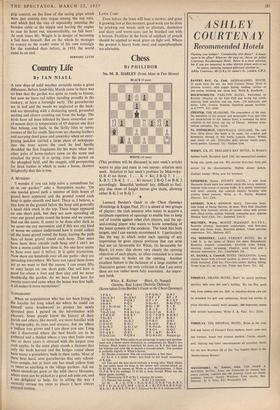Chess
By PHILIDOR
No. 94. B. HARLEY (from Mate in Two Moves) BLACK (9 men)
WHITE (10 men)
(This problem will be discussed in next week's article) WHITE to play and mate in two moves: solution next week. Solution to last week's problem by Makovsky: Q-R 4! no threat. 1 . . . K x Kt; 2 B-Q 7. 1 . . . K-B 5; 2 B-K 2. 1 ... Kt moves; 2 B-Q 7 or B-K 2 accordingly. Beautiful 'ambush' key, difficult to find: pity that three of knight moves give duals, allowing either B-K 2 or B-Q 7, Leonard Barden's Guide to the Chess Openings (Routledge & Kegan Paul, 25/-) is aimed at two groups of players: the club amateur who wants to acquire a minimum repertory of openings to enable him to keep out of trouble against other club players, and the up- and-coming player who wants to know something of the latest systems of the moderns. The book hits both targets, and I can warmly recommend it. I particularly like the way in which under each opening of any importance he gives typical positions that can arise that are (a) favourable for White, (b) favourable for Black, (c) even: this shows very clearly the opening objectives of each player, so often concealed in a mass of variations in books on the opening. Another excellent feature is the inclusion of a large number of illustrative games: my only criticism is that l am sorry these are not rather more fully annotated. An impor- tant book.
White, K. Richter Black, 0. Naegeli Opening, Ruy Lopez (Steinitz Defence) (Score taken from Barden's Guide to the Chess Openings)
16 P-Q Kt 3 Q-R 3 17 BPxP BPxP 18 P x P B x K P
19 Kt-B 3 B-Kt 57(f)
20 Kt X 13! B x R 21 R x B P X 22 Q-Q 7 eh K -B 2Kt 23 Q X' P (B 7) R-K R 2 24QXKP R-K 1 25 P-R 51 Q-B 1 26 R-Q 6! P-Kt 4
12 Kt-R 2! Q-Kt 1 (d) 27 R-B 6 ch K-Kt 1
13 P-B 4 Q-Kt 5 ' 28 B-Q 4 Q-Q 2 14 P-Q R 3 Q-B 5 29 R x R Pl Kt-B 4
15 Q-Q 2 (e) P-Q R 4 30 Q-R 8 chl Resigns (g)
(a) In this line White relies on an advantage in space and develop- ment and a better pawn formation to compensate for Black's two bishops: Black hopes to maintain his pawn on K 4 and later use his bishops and open file to launch a counter-attack. The position is probably slightly in White's favour. (6) Barden comments 'this old continuation is best here.'
(c) Kt-K 2 is rather better: text leads to too much weakening of K side,
(d) This and the next move embody a wrong idea: Black thinks he can safely keep his king in the centre and counter-attack on Q Kt file, but he cannot as White at once demonstrates. I think 12 P-K B 4 (or perhaps 12 0-0) is best, though White has the better game, anyway.
(e) Threatening 16 P-Q Kt 3, winning the queen. (f) Natural but wrong. 19 . . . B-Kt 2 is essential, (g) 30 ... R x Q; 31 R x R ch, K-B 2; 32 R-R 7 ch, K-K 3; 33 P x Kt ch. K-Q 3; 34 R x Q ch, K x R; 35 P-R 6, R-K 8 ch; 36 K-Q 2. R-K R 8; 37 B-Kt 7. followed by Kt-K 4, winning easily. 1 P-K 4 P-K 4 2 Kt-K B 3 Kt-Q B 3 3 B-Kt 5 P-Q R 3
4 B-QR 4 P-Q
5 B x Kt ch (a) P x B 6 P- 4 P-B 3
7 Q-Q 3 (8) P-K Kt 3 (c)
8 P-K R 4! P-K R 3 9 Kt-B 3 B-K 3 10 B-K 3 Kt-K2 110-0-0 B-Kt 2


































 Previous page
Previous page